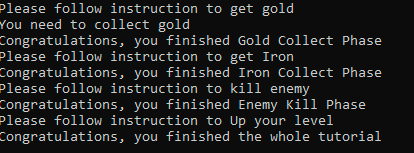大家好,老胡又在博客和大家见面了,在聊今天的主角之前,老胡先给大家讲一个以前发生的故事。
真实的故事
当老胡还是小胡的时候,跟随团队一起开发一款游戏。这款游戏是一款末日生存类游戏,玩家可以
- 收集资源,两种,一种金子,一种铁。
- 升级自身
- 击杀敌人
- 用资源合成装备
项目开发的很顺利,我那时得到一个任务,是为游戏做一个新手教程,在这个教程里面,通过一系列步骤,引导新手玩家熟悉这个游戏。游戏设计给出的教程包含以下步骤
- 收集金子
- 收集铁
- 击杀敌人
- 升级
同时要求在不用的阶段显示不同的提示以正确引导玩家。
考虑合成装备算是高级玩家才会接触到的功能,所以暂时不打算放在新手教程里面。
当老大把任务交给我的时候,我感觉简单爆了,不就写一个新手教程么,要求又那么明确,应该要不了多少时间。于是,一个上午过后,我交出了如下代码。
我的代码
定义枚举表示教程进度
首先用一个枚举,表示教程进行的不同程度
enum TutorialState
{
GetGold,
GetIron,
KillEnemy,
LevelUp
}
定义角色类
无需多言,封装收集到的资源数、击杀敌人数量、角色等级和一些升级接口等
class Player
{
private int ironNum;
private int goldNum;
private int enemyKilled;
private int level;
public int IronNum => ironNum;
public int GoldNum => goldNum;
public int EnemyKilled => enemyKilled;
public int Level => level;
public void CollectIron(int num)
{
ironNum += num;
}
public void CollectGold(int num)
{
goldNum += num;
}
public void KillEnemy()
{
enemyKilled++;
}
public void LevelUp()
{
level++;
}
}
定义教程类
定义一个教程类,包括
- 显示帮助文字以协助玩家通过当前教程步骤
- 判断玩家是否已经完成当前教程步骤,若是,切换到下一个步骤直到完成教程
class GameTutorial
{
private TutorialState currentState;
private Player player;
public GameTutorial(Player player)
{
this.player = player;
}
public void ShowHelpDescription()
{
switch (currentState)
{
case TutorialState.GetGold:
Console.WriteLine("Please follow instruction to get gold");
break;
case TutorialState.GetIron:
Console.WriteLine("Please follow instruction to get Iron");
break;
case TutorialState.KillEnemy:
Console.WriteLine("Please follow instruction to kill enemy");
break;
case TutorialState.LevelUp:
Console.WriteLine("Please follow instruction to Up your level");
break;
default:
throw new Exception("Not Support");
}
}
public void ValidateState()
{
switch (currentState)
{
case TutorialState.GetGold:
{
if (player.GoldNum > 0)
{
Console.WriteLine("Congratulations, you finished Gold Collect Phase");
currentState = TutorialState.GetIron;
}
else
{
Console.WriteLine("You need to collect gold");
}
break;
}
case TutorialState.GetIron:
{
if (player.IronNum > 0)
{
Console.WriteLine("Congratulations, you finished Iron Collect Phase");
currentState = TutorialState.KillEnemy;
}
else
{
Console.WriteLine("You need to collect Iron");
}
break;
}
case TutorialState.KillEnemy:
{
if (player.EnemyKilled > 0)
{
Console.WriteLine("Congratulations, you finished Enemy Kill Phase");
currentState = TutorialState.LevelUp;
}
else
{
Console.WriteLine("You need to kill enemy");
}
break;
}
case TutorialState.LevelUp:
{
if (player.Level > 0)
{
Console.WriteLine("Congratulations, you finished the whole tutorial");
currentState = TutorialState.LevelUp;
}
else
{
Console.WriteLine("You need to level up");
}
break;
}
default:
throw new Exception("Not Support");
}
}
}
测试代码
static void Main(string[] args)
{
Player player = new Player();
GameTutorial tutorial = new GameTutorial(player);
tutorial.ShowHelpDescription();
tutorial.ValidateState();
//收集黄金
player.CollectGold(1);
tutorial.ValidateState();
tutorial.ShowHelpDescription();
//收集木头
player.CollectIron(1);
tutorial.ValidateState();
tutorial.ShowHelpDescription();
//杀敌
player.KillEnemy();
tutorial.ValidateState();
tutorial.ShowHelpDescription();
//升级
player.LevelUp();
tutorial.ValidateState();
}
运行结果

看起来一切都好。。编写的代码既能够根据当前步骤显示不同的提示,还可以成功的根据玩家的进度切换到下一个步骤。
于是,我自信满满的申请了code review,按照我的想法,这段代码通过code review应该是板上钉钉的事情,谁知,老大看到代码,差点没背过气去。。。稍微平复了一下心情之后,他给了我几个灵魂拷问。
- GameTutorial需要知道各个步骤的满足条件和提示,它是不是知道的太多了?这符合迪米特法则吗?
- 如果我们游戏之后新增一个教程步骤,指导玩家升级武器,是不是GameTutorial需要修改?能有办法规避这种新增的改动吗?
- 如果我们要修改现在的教程步骤之间的顺序关系,GameTutorial是不是又不能避免要被动刀?能有办法尽量减少这种修改的工作量吗?
- Switch case 在现有的情况下已经如此长,如果我们再加入新的步骤,这个方法会变成又臭又长的裹脚布吗?
当时我的表情是这样的

本来以为如此简单的一个功能,没想到还是有那么多弯弯道道,只怪自己还是太年轻啊!最后他悠悠的告诉我,去看看状态模式吧,想想这段代码可以怎么重构。
状态模式出场
定义
对象拥有内在状态,当内在状态改变时允许其改变行为,这个对象看起来像改变了其类
有点意思,看来我们可以把教程的不同步骤抽象成不同的状态,然后在各个状态内部实现切换状态和显示帮助文档的逻辑,这样做的好处是
- 符合迪米特法则,把各个步骤所对应的逻辑推迟到子类,教程类就不需要了解每个步骤的逻辑细节,同时隔离了教程类和状态类,确保状态类的修改不会影响教程类
- 符合开闭原则,如果新添加步骤,我们仅仅需要添加步骤子类并修改相邻的步骤切换逻辑,教程类无需任何改动
接着我们看看UML,

一目了然,在我们的例子里面,state就是教程子步骤,context就是教程类,内部包含教程子步骤并转发请求给教程子步骤,我们跟着来重构一下代码吧。
代码重构
创建状态基类
第一步我们需要删除之前的枚举,取而代之的是一个抽象类当作状态基类,即,各个教程步骤类的基类。注意,每个子状态要自己负责状态切换,所以我们需要教程类暴露接口以满足这个功能。
abstract class TutorialState
{
public abstract void ShowHelpDescription();
public abstract void Validate(GameTutorial tutorial);
}
重构教程类
重构教程类体现在以下方面
- 添加内部状态表面当前处于哪个步骤,在构造函数中给予初始值
- 暴露接口以让子状态能修改当前状态以完成状态切换
- 因为需要子状态能访问玩家当前数据以判断是否能切换状态,需要新加接口以避免方法链
- 修改ShowHelpDescription和ValidateState的逻辑,直接转发方法调用至当前状态
class GameTutorial
{
private TutorialState currentState;
private Player player;
public int PlayerIronNum => player.IronNum;
public int PlayerLevel => player.Level;
public int PlayerGoldNum => player.GoldNum;
public int PlayerEnemyKilled => player.EnemyKilled;
public void SetState(TutorialState state)
{
currentState = state;
}
public GameTutorial(Player player)
{
this.player = player;
currentState = TutorialStateContext.GetGold;
}
public void ShowHelpDescription()
{
currentState.ShowHelpDescription();
}
public void ValidateState()
{
currentState.Validate(this);
}
}
创建各个子状态
接着我们创建各个子状态代表不同的教程步骤
class TutorialSateGetGold : TutorialState
{
public override void ShowHelpDescription()
{
Console.WriteLine("Please follow instruction to get gold");
}
public override void Validate(GameTutorial tutorial)
{
if (tutorial.PlayerGoldNum > 0)
{
Console.WriteLine("Congratulations, you finished Gold Collect Phase");
tutorial.SetState(TutorialStateContext.GetIron);
}
else
{
Console.WriteLine("You need to collect gold");
}
}
}
class TutorialStateGetIron : TutorialState
{
public override void ShowHelpDescription()
{
Console.WriteLine("Please follow instruction to get Iron");
}
public override void Validate(GameTutorial tutorial)
{
if (tutorial.PlayerIronNum > 0)
{
Console.WriteLine("Congratulations, you finished Iron Collect Phase");
tutorial.SetState(TutorialStateContext.KillEnemy);
}
else
{
Console.WriteLine("You need to collect iron");
}
}
}
class TutorialStateKillEnemy : TutorialState
{
public override void ShowHelpDescription()
{
Console.WriteLine("Please follow instruction to kill enemy");
}
public override void Validate(GameTutorial tutorial)
{
if (tutorial.PlayerEnemyKilled > 0)
{
Console.WriteLine("Congratulations, you finished enemy kill Phase");
tutorial.SetState(TutorialStateContext.LevelUp);
}
else
{
Console.WriteLine("You need to collect kill enemy");
}
}
}
class TutorialStateLevelUp : TutorialState
{
public override void ShowHelpDescription()
{
Console.WriteLine("Please follow instruction to level up");
}
public override void Validate(GameTutorial tutorial)
{
if (tutorial.PlayerLevel > 0)
{
Console.WriteLine("Congratulations, you finished the whole tutorial");
}
}
}
添加状态容器
这是模式中没有提到的知识点,一般来说,为了避免大量的子状态对象被创建,我们会构造一个状态容器,以静态变量的方式初始化需要使用的子状态。
static class TutorialStateContext
{
public static TutorialState GetGold;
public static TutorialState GetIron;
public static TutorialState KillEnemy;
public static TutorialState LevelUp;
static TutorialStateContext()
{
GetGold = new TutorialSateGetGold();
GetIron = new TutorialStateGetIron();
KillEnemy = new TutorialStateKillEnemy();
LevelUp = new TutorialStateLevelUp();
}
}
测试代码
测试代码部分保持不变,直接运行,结果和原来一样,重构成功。
结语
这就是状态模式和它的使用场景,比较一下重构前和重构后的代码,发现代码通过重构满足了开闭原则和迪米特法则,相信重构后的代码能通过code review吧。_
不过状态模式虽然好,也有自己的缺点,因为需要一个子类对应一个子状态,那么子状态太多的时候,就会出现类爆炸的情况。还请大家多注意。
作为行为模式之一的状态模式,在日常开发中出现的频率还是挺高的,比如游戏中经常用到的状态机,就是状态模式的一种应用场景,大家在平时工作中保持善于观察的眼睛,就能学到更多的东西。
今天就讲到这里吧,谢谢大家的阅读,下次见。